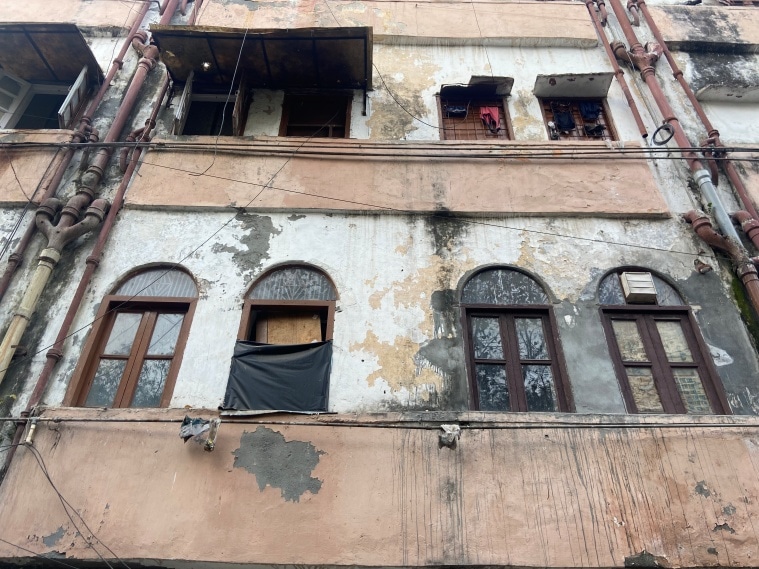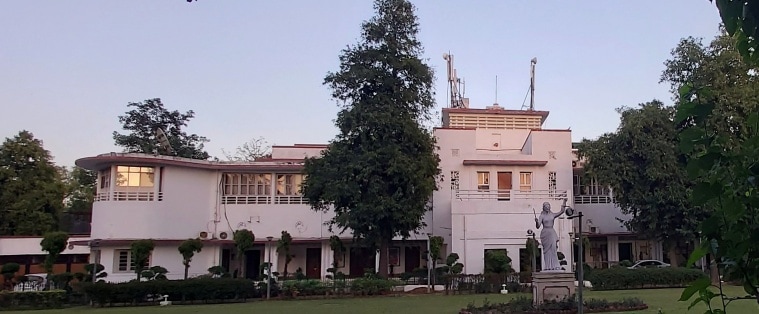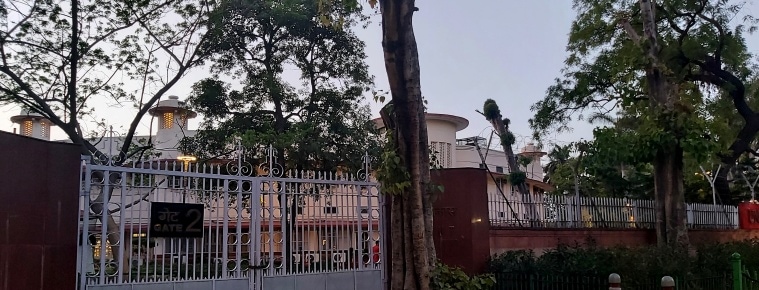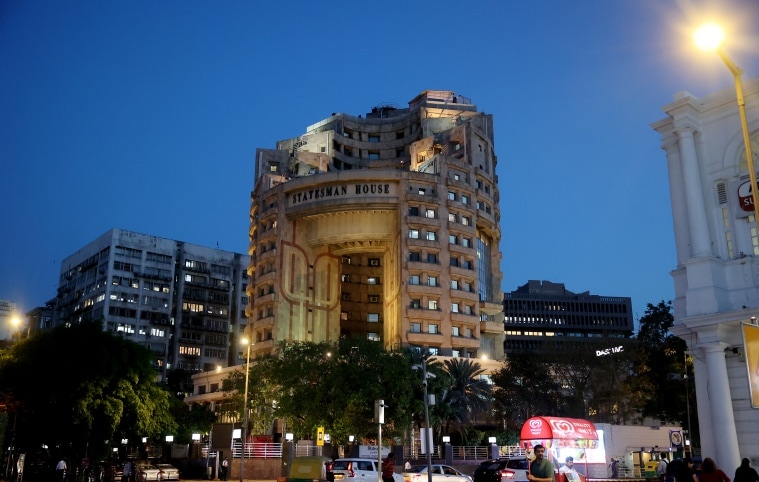Delhi’s every ‘just another old building’ could be an Art Deco gem
Unlike Mumbai, where South Mumbai’s Art Deco and Victorian buildings are formally recognised as UNESCO’s World Heritage, Delhi’s Art Deco seldom attracts attention. Read to know the reasons and more.
 The Sujan Singh Park apartment complex displays features of classical and art deco styles. (Express Photo by Tashi Tobgyal)
The Sujan Singh Park apartment complex displays features of classical and art deco styles. (Express Photo by Tashi Tobgyal) ‘At Home in Delhi’ is a five-part series exploring Delhi beyond its monumental architecture, taking a close look at the everyday structures that make the city unique. The series will delve into the history, design, and significance of the various buildings that make Delhi and how they reflect the cultural, social, and economic forces at play. Beginning with the age-old havelis, the series will move on to Art Deco homes, DDA housing, industrial housing, and lastly, modern housing.
“We don’t know what art deco is. This is our home, and we have lived here for generations. My parents work in the ‘flats’. I understand that the balconies and windows of our home are unique and stand out compared to the other buildings in the city,” says 32-year-old Akanksha who lives in the “servants’” quarter of Sujan Singh Complex, a stone’s throw from Khan Market. Her building, dilapidated with signs of years of erosion and temporary fixes, still has curved lintels on the windows and curved balconies amid chipped paint and exposed bricks. “We like living here, but for some years now, some of the sections have had seepage and other problems. If I save enough, maybe we can move out and buy a modern house. A big one like the ‘flats’,” says Akanksha.
Sujan Singh Park, now one of the most exclusive residential blocks of Delhi, was conceived in 1943 by the central government to house British military and civilian officers during the Second World War. The apartment complex displays features of classical and art deco styles; however, while the “flats” with their broad stairways and high ceilings have been described as the “epicentre of Delhi’s English-speaking elite”, the shabby quarters house 1,700 families of the domestic staff that work here.
 The shabby quarters inside Sujan Singh Park house 1,700 families of the domestic staff that work here. (Photo-Ekta Chauhan)
The shabby quarters inside Sujan Singh Park house 1,700 families of the domestic staff that work here. (Photo-Ekta Chauhan)
In fact, the two worlds of Sujan Singh Complex are also the worlds of the city’s classical and art deco heritage – one of the state houses and government buildings in Lutyen’s Zone and the other of crumbling housing and commercial complexes scattered in areas like Chandni Chowk, Karol Bagh and Daryanganj.
The origins of the style
Art Deco is a distinctive style of architecture and design that emerged in the early 20th century, characterised by geometric shapes, streamlined forms, and decorative motifs inspired by ancient cultures such as Egyptian and Aztec executed with modern technology. While Art Deco is often associated with the glamour and luxury of the 1920s and 1930s, it also left an indelible mark on the urban landscape of Delhi where many Art Deco buildings still stand today. Unlike other heritage structures in the capital, such as tombs, forts, and parks, Art Deco buildings in Delhi are not just historical artefacts but also remain active parts of the city’s urban fabric.
The Art Deco style originated in France, where it was showcased at the Exposition Internationale des Arts Décoratifs et Industriels Modernes in 1925. The style drew inspiration from various sources, including ancient Egyptian and Mesopotamian architecture, modern technology, and avant-garde art movements such as Cubism and Futurism.
The largest concentration of the style in India is in Mumbai, where the style was first introduced by the British and adopted quickly by the western educated architects and patrons who wanted to signal their prosperity and western lifestyles. In Delhi, Art Deco buildings were constructed mainly in the 1930s and 1940s, during rapid urbanisation and modernisation. As Delhi was chosen to be the new capital of British India, a new wave of construction activity began in the city that sought to position Delhi as the worthy capital of a vast empire. But unlike Mumbai, where South Mumbai’s Art Deco and Victorian buildings are formally recognised as UNESCO’s World Heritage, Delhi’s Art Deco seldom attracts attention.
 The Jaisalmer House (Express Photo by Praveen Khanna)
The Jaisalmer House (Express Photo by Praveen Khanna)
Samarth Seth (24), an architect and researcher of Indian origin in Germany, emphasises understanding the socio-political and economic conditions in which Art Deco emerged in Europe and subsequently travelled to India. He says, “Art Deco started as a design form and later adapted into architectural plans, and thus you can notice the heavy emphasis on intricate designs and ornamentations. This was a labour and capital-intensive form and therefore took a hit in post-war Europe. The form took its own course in India, where the emphasis shifted to local elements such as jalis, circular openings and arches, aided by the different Indian brick sizes”.
Art Deco architecture in Delhi is characterised by its bold, geometric shapes, stylised motifs, and attention to detail. Many Art Deco buildings here feature elaborate façades with intricate ornamentation, such as zigzag patterns, sunburst motifs, and stepped forms. Their interiors often include spacious lobbies, decorative lighting fixtures and intricate wrought-iron railings. Art Deco in Delhi was commissioned by its wealthy political and business class who wanted to showcase their avant garde taste and modernity. Indian royals played a crucial role in introducing Art Deco to Delhi as they were allotted land for residences in the city during British rule and had exposure to the style through their travels to the West in luxury ocean liners. Landmark buildings built by the princely families such as the Kota House, Dholpur House, Jaisalmer House, and Faridkot House reflect the style’s bold geometric forms and bright colours.
 The Dholpur House (Express Photo by Praveen Khanna)
The Dholpur House (Express Photo by Praveen Khanna)
Beyond monuments
Art deco can be seen all over Delhi, from grandiose public buildings, commercial complexes, public infrastructure such as hotels and cinemas and residential bungalows. However, due to its everyday prevalence, it is often overlooked by the city’s residents, visitors and often researchers. While on the one hand are the iconic structures such as Connaught Place, Imperial Hotel and Statesman House, there are other more “mundane” buildings that a passer-by might miss as “just another old building”. For example, Charan Bhawan , constructed in 1945 in Model Basti area of Sadar Bazar, displayed interesting hybrid features such as a central rising tower flanked with symmetrically curved balconies, eyebrowed cantilevers, porthole windows and use of Hindu deities in ornamentation. Unfortunately, the building was recently demolished, as documented by the Deco in Delhi team.
In addition to its impact on architecture, Art Deco also influenced other design aspects in Delhi during the 1930s and 1940s. The style’s bold use of colour and geometric shapes can be seen in the city’s furniture, textiles, and other decorative arts from this period. As the trend symbolised modernity, Art Deco buildings often have modern functions (cinema halls, markets, banks) with a distinct expression of vernacular idioms.
 The Statesman House (Express Photo by Praveen Khanna)
The Statesman House (Express Photo by Praveen Khanna)
The story of Art Deco in Delhi acts as a tangible record of modern history and the moods it cultivated. For example, The Ram Rup Clock Tower in Old Delhi’s Sabzi Mandi reflects the contours of the economy and society of its time. Built in 1938 by affluent businessman Ram Roop, the tower served the public function of keeping time, a practice necessary for industry. The tower overlooks the towers and chimneys of nearby mills and skirts the trams connecting the city’s labouring class with its industrial outposts. Other famous buildings from the time included Delhi’s first airport, the Willingdon Airport (constructed 1936 ), with its upper half constructed like a ship/cruise, and the All India Radio Bhawan (constructed 1943) with terrazzo flooring.
Varun Shiv, who runs a blog titled “sarson kay khet” extensively documenting the architectural and urban history of India, suggests the phrase “desi deco” to refer to the early 20th-century structures in the city. According to him, these buildings utilised elements of Art Deco but adapted them to suit their specific architectural requirements resulting in designs and motifs that were undoubtedly Art Deco, but with modifications that deviated from the “canonical” Art Deco style. This style was vastly different from the iconic Art Deco skyscrapers found in cities such as New York, Miami or Mumbai. It was modified not only in physical style and elements but also in its venue, scale, purpose, and meaning. The term Desi Deco, thus, emphasises the “indigenized” nature of this altered and modified version of Art Deco.
The concentration of this style in areas such as Sadar Bazar, Karol Bagh, Paharganj tells the story of the city’s expansion in the early 20th century. By the 1920s, the Mughal capital of Shahjahanabad was already congested, and the British Lutyens Delhi was reserved for the ruling class. The wealthy merchants and traders, thus, started to settle on the western flank of Shahjahanabad, experimenting with designs and motifs from Art Deco, colonial neo-classicism, indigenous traditions and haveli architecture.
 St. Stephen’s College (Express file Photo)
St. Stephen’s College (Express file Photo)
Fusion of Indian and western visual ideas can also be seen in structures like St. Stephen’s College, Delhi University, where the Anglo-Indian architect Walter Sykes George incorporated Indian classical elements with Christian values and drew inspiration from Art Deco in parts of the building’s central entrance tower, staircase design and the extended front porch. Decorative details can also be spotted in its jaalis, some with the “SS” pattern reflecting the college’s initials.The style has kept pace with the city’s development, and its desires and aspirations. To understand the proliferation of the Deco mode, it is essential to look beyond ornamentation and understand the broader socio-political conditions of the time when the country was standing at the cusp of the transition from a colony to a new nation-state.
Gradual decline
Despite their historical and cultural significance, many Art Deco buildings in Delhi have fallen into disrepair over the years due to lack of awareness about their heritage value and the effects of natural wear and tear. Some of these structures are also threatened by demolition as developers seek to make way for modern high-rise buildings and commercial complexes. There is also a lack of awareness even amongst the residents who live in such buildings as they neither qualify to be traditional Indian houses (like havelis) nor are they swanky enough to be called “modern”. For most of the residents, their houses are “just old”.
The decline of preference for Art Deco in Delhi can be attributed to several factors. One of the main reasons was the emergence of modernist architecture, which took over the architectural landscape of Delhi post-independence. Modernist architecture was seen as a symbol of progress and development, which suited the ideals of the newly independent country. The clean lines, minimalism, and functionality of modernist architecture were deemed more appropriate for an emerging India, as opposed to the ornate and decorative Art Deco style.
Revival of interest
There is, however, a growing recognition for the need of preserving Delhi’s Art Deco heritage. There is also a resurgence of interest in Art Deco worldwide, contributing to the revival of this unique heritage in Delhi. The style’s bold, geometric forms and striking visual appeal have inspired a new generation of architects and designers who are looking to reinvent and reinterpret the Art Deco aesthetic for the 21st century.
Geetanjali Sayal and Prashansa Sachdeva started the Deco in Delhi project to document urban heritage and help citizens connect with their city more meaningfully. Geetanjali was interested in cultural identities of cities, having done her Masters in Narrative Environments from Central Saint Martins (London, UK) and teamed up with Prashansa, an architect from Welsh School of Architecture (Cardif, UK). They wanted to move beyond the monumental architecture of the city and look at “unrecognised” heritage buildings. What started as a passion project during the Covid-19 lockdown is now a comprehensive encyclopaedia of Delhi’s Art Deco architecture, created with a grant from the India Foundation for Arts.
The team has not only extensively documented structures but people and firms that contributed to the growth of this style. These include architects like N K Kothari who worked for Mumbai-based architectural firm Master, Sathe and Bhuta and patrons like Lala Ram Roop and Lala Raghumal. Sayal says that through this project, their vision is to “foster a sense of ownership and belonging, especially among the younger generations who often feel alienated in cities”.
For Sayal, the questions around preservation can be raised only after people know that a particular building is worth protecting. She says, “Residents often do not want to talk to us about the details of their private homes. There is also a fear that if the building becomes a heritage building, it would come under heavy regulation, thus making any changes difficult.” The project aims to expand to workshops, walks and other forms of on-ground initiatives to engage people with the style.
Professor of architecture and heritage conservation, Priya Jain argues that India’s 20th-century built heritage is still considered very new. In her 2020 paper “India’s modern heritage: conservation challenges and opportunities”, taking the example of modern heritage in cities like Delhi, Chandigarh and Ahmedabad, she argues that architecture, such as Art Deco, is pervasive and commonplace in our cities and often appreciated solely by the professional elite. Making a case for their careful preservation, she says, “these buildings are emblematic of so much more – of massive upheavals in the political, social, cultural, and technological futures of the country. Built over a relatively short span, this ‘recent past’ is important for much the same reason as most heritage is – to enable a deeper understanding of our place in the present and future. Despite the illegitimacy of age, there are buildings and ensembles from this cohort that merit preservation”.
Despite the growing interest in the art deco architecture of Delhi, these buildings are not officially recognised or protected by the Archaeological Survey of India (ASI). According to its policy, only buildings over 100 years old are considered for heritage status and protection under the Ancient Monuments and Archaeological Sites and Remains Act (AMASR). This means many Art Deco buildings in Delhi, built in the 1930s and 1940s, are not eligible for protection. Some have been demolished or altered beyond recognition, while others have been repurposed for commercial use without regard for their historical or architectural significance.
Laurent Glattli, a PhD scholar at the South Asian Department, Humboldt University (Berlin) working on heritage conservation in post-independence South Asia, argues that “it is not just about temporality but also the scope of what ASI considers worthy of protection. Most of the time, individual houses are not considered monumental enough to be preserved. A number of buildings in cities such as Mumbai are also under municipal protection. So we should also consider conservation at the state or municipal level and not necessarily at the national level”.
While the older structures are slowly disappearing , the glamour of this early 20th century form continues to inspire designers and architects looking to reinterpret the style with modern penchant. Delhi based Untitled Designs, for example, use the style to create modern and urban residencies with traditional techniques and inspirations. The story of Delhi’s Art Deco is thus being rewritten and redesigned, reflecting the desires and aspirations of a new generation of architects and their elite patrons.
Further reading:
Chalana, M., & Krishna, A. (Eds.), Heritage Conservation in Postcolonial India: Approaches and Challenges (1st ed.). Routledge, 2020.
Sumanta K. Bhowmick, Princely Palaces in New Delhi, Niyogi Books, 2016.
Shrikant Sathe & Shirish Joshi, The Emergence of an Indigenous Practice in India – Selected Works of Master, Sathe, & Bhuta, Architecture and Design Foundation (India), 2022.
Abigail McGowan, Domestic Modern: Redecorating Homes in Bombay in the 1930s, Journal of the Society of Architectural Historians, 2016.



- 01
- 02
- 03
- 04
- 05




























